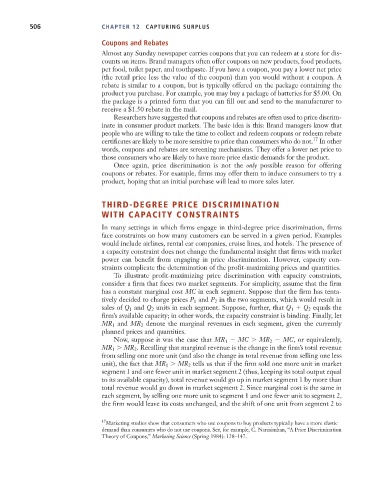Page 532 - Microeconomics, Fourth Edition
P. 532
c12capturingsurplus.qxd 7/22/10 1:03 PM Page 506
506 CHAPTER 12 CAPTURING SURPLUS
Coupons and Rebates
Almost any Sunday newspaper carries coupons that you can redeem at a store for dis-
counts on items. Brand managers often offer coupons on new products, food products,
pet food, toilet paper, and toothpaste. If you have a coupon, you pay a lower net price
(the retail price less the value of the coupon) than you would without a coupon. A
rebate is similar to a coupon, but is typically offered on the package containing the
product you purchase. For example, you may buy a package of batteries for $5.00. On
the package is a printed form that you can fill out and send to the manufacturer to
receive a $1.50 rebate in the mail.
Researchers have suggested that coupons and rebates are often used to price discrim-
inate in consumer product markets. The basic idea is this: Brand managers know that
people who are willing to take the time to collect and redeem coupons or redeem rebate
17
certificates are likely to be more sensitive to price than consumers who do not. In other
words, coupons and rebates are screening mechanisms. They offer a lower net price to
those consumers who are likely to have more price elastic demands for the product.
Once again, price discrimination is not the only possible reason for offering
coupons or rebates. For example, firms may offer them to induce consumers to try a
product, hoping that an initial purchase will lead to more sales later.
THIRD-DEGREE PRICE DISCRIMINATION
WITH CAPACITY CONSTRAINTS
In many settings in which firms engage in third-degree price discrimination, firms
face constraints on how many customers can be served in a given period. Examples
would include airlines, rental car companies, cruise lines, and hotels. The presence of
a capacity constraint does not change the fundamental insight that firms with market
power can benefit from engaging in price discrimination. However, capacity con-
straints complicate the determination of the profit-maximizing prices and quantities.
To illustrate profit-maximizing price discrimination with capacity constraints,
consider a firm that faces two market segments. For simplicity, assume that the firm
has a constant marginal cost MC in each segment. Suppose that the firm has tenta-
tively decided to charge prices P and P in the two segments, which would result in
1
2
sales of Q and Q units in each segment. Suppose, further, that Q Q equals the
1
1
2
2
firm’s available capacity; in other words, the capacity constraint is binding. Finally, let
MR and MR denote the marginal revenues in each segment, given the currently
1
2
planned prices and quantities.
Now, suppose it was the case that MR MC MR MC, or equivalently,
2
1
MR MR . Recalling that marginal revenue is the change in the firm’s total revenue
2
1
from selling one more unit (and also the change in total revenue from selling one less
unit), the fact that MR MR tells us that if the firm sold one more unit in market
2
1
segment 1 and one fewer unit in market segment 2 (thus, keeping its total output equal
to its available capacity), total revenue would go up in market segment 1 by more than
total revenue would go down in market segment 2. Since marginal cost is the same in
each segment, by selling one more unit to segment 1 and one fewer unit to segment 2,
the firm would leave its costs unchanged, and the shift of one unit from segment 2 to
17 Marketing studies show that consumers who use coupons to buy products typically have a more elastic
demand than consumers who do not use coupons. See, for example, C. Narasimhan, “A Price Discrimination
Theory of Coupons,’’ Marketing Science (Spring 1984): 128–147.

